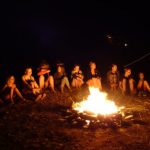

More than twenty years ago I visited Ellis Island with the Dutch Museum Association. This visit made a huge impression on me, because it was the first time that I experienced oral history in such an intrusive manner. In the exhibition there were shots of interviews with survivors of the Holocaust. The orality of the source made huge impact. But there was more. It was not like the deep dark secret of oral history that nobody wants to spend much time listening or watching recorded and collected interview documents as Michael Frisch stated. (2008) On the contrary we were watching and listening carefully emotionally involved by facial expression, gesture, tone, body language, pauses, movements. To make a recorded video interview part of an exhibition is a good example of a possibility emerging after the interview.
Therefore I was very much amazed reading in the article “Telling Stories: a reflection on oral history and new media” van Stephen High(2010) the quote below written by Elizabeth Miller: “What would happen, if academics spent ninety percent of their time finding ways to connect with various publics”. As a public historian it’s obvious that you have to think about ways to interest a wide audience for the story you have discovered and want not only to tell, but to share as well. New media could help historians reaching this goal.
Were people sharing memories by telling stories around the campfire in the past, discussing and debating, asking questions, giving different perspectives, nowadays people do the same by using social media on the internet. Therefore, Chris Anderson the founder of TEDx launched the idea to see the world- wide- web as the new campfire to share and discuss stories around.
Indeed new media tools are opening up exciting new possibilities for community engagement and shared authority after the interview which are necessary to make the ‘ digital stories deep and powerful’ according to Rina Benmayor, but there is more.
I also visited the United States Holocaust Memorial Museum in Washington dc. Here I experienced the emotional impact of oral history even more entering the elevator to the third floor where the exhibition starts. An American World War II soldier was telling what he had seen when liberating concentration camp Auswitch. Here the recorded voice was especially used as a means to get the visitor emotionally involved in the topic of the exhibition.
This emotional engagement was reinforced by the huge color picture of a pile of bodies I saw getting of the elevator. Such an image is even more penetrating then voice and the combination of the voice and the image lead to a very emotional experience and a huge impact.
Steven High created a cross-disciplinary methodology that combines oral history with digital storytelling, searchable databases and memoryscapes, but not with images belonging to the stories which are so powerful for giving the life history context, even not in the five year project lifestoriesmontreal.ca.
In the experience economy a wide public wants to become emotionally involved in stories. (Pine &Gilmore). Therefore it’s important to make the story visible and tangible by combining images, objects, oral history and memoryscapes in one moving experience as they did in the National Holocaust Museum Amsterdam.
Digital technologies are opening up new horizons for community and public engagement on the one hand and sharing authority on the other. Communities are supposed partner in the project, not just objects of study. Historians are collecting the stories of a community, but on social media people are sharing their stories as well. Historians could search the internet to find stories of their interest. They could also involve communities on the internet by asking them to participate and co-create digital storytelling. However most of the time stories on the internet are told with very few words illustrated by uploading images. Those images are really important in digital storytelling and historians in general are not very aware of the potency of the image to make the story visible and tangible.
New Media tools are opening up many possibilities to interact with all kind of sources, but also with the interviewee, the community and a wide public. This is shared authority in the broadest sense leading to participation, co- creation and different perspectives. The internet offers an incredible opportunity to tell stories without losing the voice of interviewees and using the emotional power of images to engage communities and interact with a broad audience, sharing their emotions as people did around the campfire in the past.
Frederike van Ouwerkerk